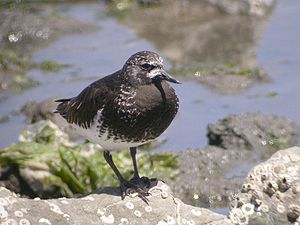Schwarzkopf turnstone
| Schwarzkopf turnstone | ||||||||||||
|---|---|---|---|---|---|---|---|---|---|---|---|---|

Schwarzkopf Turnstone ( splendid dress ) |
||||||||||||
| Systematics | ||||||||||||
|
||||||||||||
| Scientific name | ||||||||||||
| Arenaria melanocephala | ||||||||||||
| ( Vigors , 1829) |

The Schwarzkopf turnstone ( Arenaria melanocephala ) is a monotypical species of bird from the family of snipe birds. The species occurs exclusively in the Nearctic . Compared to the closely related and circumpolar turnstone , the distribution area of the Schwarzkopf turnstone is very small. The IUCN classifies the Schwarzkopf Turnstone as harmless ( least concern ).
Appearance
The Schwarzkopf Turnstone reaches a body length of 22 to 25 centimeters. The wingspan is 50 to 55 centimeters. The weight varies between 100 and 140 grams.
In the splendid dress, the Schwarzkopf Turnstone has a black head with very fine dotted lines on the top of the head and the neck. The white spot on the base of the beak is particularly noticeable. The beak is black, the iris is dark brown. The throat and chest are black, but individual feathers are lined with white so that they appear thickly spotted with white. The underside of the body is white, only the upper flanks are colored similar to the breast. The back, the torso and the upper tail-coverts are white, the tail is black. The legs and feet are dark red-brown, in some individuals even orange-brown. In the plain dress, the Schwarzkopf Turnstone is similarly colored, but the fine white spots are significantly reduced and, above all, the white spot on the base of the beak is missing. Young birds are similar to the adult birds in the plain dress, but with them the breast is gray-brown and the top of the body is dark brown. The downy chicks are spotted black and cream.
Distribution area
The Schwarzkopf Turnstone is only found in western and southern Alaska. It prefers rockier coasts than the Turnstone and is an obligatory migratory bird that can be found on the west coast of the United States and in Baja California during the winter months. Here, too, it prefers rocky coasts, but is also observed on beaches and on floodplains.
Way of life
The Schwarzkopf turnstone eats invertebrates and occasionally the eggs of other small bird species. It lives sociable in the winter months, while the males defend breeding grounds during the breeding season. It very often uses the same breeding area as the year before. The nest is a hollow scratched by the male, which is usually located near the water. The clutch consists of three to four eggs. These are pale olive in color or pale green with gray or olive brown spots. The breeding season is 20 to 22 days, both parent birds are involved in the breeding. The chicks flee the nest and are fledged and led by both parent birds. They are fledged between 25 and 30 days of age.
supporting documents
literature
- Richard Sale: A Complete Guide to Arctic Wildlife , published by Christopher Helm, London 2006, ISBN 0-7136-7039-8
Single receipts
Web links
- Arenaria melanocephala inthe IUCN 2013 Red List of Threatened Species . Listed by: BirdLife International, 2012. Retrieved October 7, 2013.